Meet Ani Anderson, a trailblazer in the professional coaching and training industry. Her company is renowned for their transformative impact on individuals and organizations alike. With a wealth of experience and a passion for empowering others to reach their full potential, Ani’s team has earned the reputation as a trusted advisor to leaders. Through their innovative coaching methods and dynamic training programs, they have guided countless clients to achieve breakthroughs in their personal and professional lives.
Join us as we delve into the inspiring journey and profound insights of this visionary leader, dedicated to driving positive change and excellence in the world of coaching and training. In conversation with Ani Anderson, Director of Operations at Motivation Beyond Measure, let us know more about her journey.
1. Please walk us through your educational/professional journey. What was the ‘aha moment’ that inspired you to venture into the industry you are working in?
During my junior year in college, while training to become an Occupational Therapist, I encountered a significant health challenge that left doctors puzzled. Despite their efforts, they couldn’t pinpoint the cause of my symptoms. It was during this uncertain period that I stumbled upon a book about energy medicine.
Intrigued by its concepts, I followed the book’s guidance, answering questions related to the parts of my body affected by the symptoms. Through this process, I uncovered unresolved issues within my family that seemed connected to my health struggles. Taking a bold step, I addressed these issues in a conversation with my mother, and remarkably, my symptoms vanished.
Though it felt like a stroke of magic, this experience sparked a realization within me. I saw the potential of energy medicine to transform not only individual health but also our broader approach to wellness. Motivated by this insight, I felt a calling to explore energy medicine further, sensing its significance for society.
In that ‘aha moment,’ I understood that my journey wasn’t just about my own healing but also about contributing to a new perspective on health and wellness. This revelation fueled my passion to study the intersection of traditional and alternative medicine, shaping my career path into what it is today.
I went on to create my own private practice then branched out with my partner to train other practitioners. Our companies have walked the leading edge by bringing energy medicine into organizations and professional practices in very practical ways since 2012.
2. When was the company established? What are the products/services it primarily offers?
NEW Health Inc was established in 2012. We are the home of the Somatic Coaching Academy and Motivation Beyond Measure. Our company provides professional development training and coaching. The Somatic Coaching Academy offers certification programs in body-centered coaching methodologies. Certification programs range from 2 days to 6 months and offer the most cutting-edge neuroscience available so that practitioners can get the very best results with even the most challenging and resistant people. Motivation Beyond Measure is our professional practice and offers solutions to leaders who are dedicated to getting unprecedented levels of motivation with their teams.
3. When we asked Ani Anderson about the three unique factors that differentiate the company, she had an insightful answer, showing how Motivation Beyond Measure will never fail to give its customer the edge!
The three unique factors are she talked about are –
Coach training programs offer coaching at 3 basic levels; coaching the “what,” coaching the “who,” and coaching the “state.” Coaches that coach the “what” for a client partner with their clients to find solutions that match the problem they are having. Coaches who coach the “who” focus more on who the person is being in the situation. Coaching the “state” means that we help a client regulate their nervous system and choose their desired sensory state before approaching future action.
An example of this follows:
A client wants to exercise more, but can’t get themselves to go to the gym.
Coaching the “what,” the coach will help the client identify the best exercises they are most likely to do, the best time of the day to go to the gym, and how they might develop accountability measures that will support their goal.
Coaching the “who,” the coach will help the client to identify an underlying belief that is keeping the client from exercising. Uncovering a belief that the client thinks they are lazy, the coach helps them shift instead into a belief that “I am an athlete.”
Coaching the “state,” the coach will first help a person regulate their nervous system to make sure they are within their window of tolerance and ready to enter their nervous system growth zone. From there they will help the person identify the “feelings”/sensations that are blocking their goal, modify the sensations from undesired sensations to desired sensations, and then help them identify thoughts, words, and actions they would like to take from the desired state.
Coaching the “state” is the magic key a lot of coaches are looking for because coaching the “what” and the “who” only works some of the time, whereas coaching the state works for everyone no matter what they have been through. Coaches find they get exceptional results with even the most challenging clients when coaching the “state” first before approaching the “who” or the “what.”
At the Somatic Coaching Academy, our coaches learn how to coach the nervous system state. The methods we teach are trauma-sensitive. However not all of our students choose to study with us so that they have trauma-sensitive coaching methods, but many do, understanding that 90% of people have traumatized nervous systems and no one can opt out of working with clients who have experienced trauma. Since trauma can show up as insidious problems like procrastination issues and lack of motivation, our students find that the coachees they thought were “uncoachable” or “difficult” really just needed somatic coaching methods to succeed.
Our team at Motivation Beyond Measure has been trained through the Somatic Coaching Academy so that they provide the most cutting-edge science and practical application for leaders and teams in any leadership development and change initiatives. We dive deeper than emotional intelligence so that leaders can understand what motivates 100% of their teams and get lasting results faster and more completely than other consulting firms.
4. Leading and establishing a company with passion and dedication have made Ani Anderson the successful leader she is today! But not without failures and setbacks to overcome. So, how do you handle those and what are some important leadership lessons you have learned throughout your journey?
As a business leader, I’ve learned to see setbacks as hidden chances for growth. Each time we face a setback, it’s like finding a secret opportunity waiting to be discovered. This mindset has been key to our success over the years.
Let me tell you about a couple of tough times we faced. Back in 2012, our wellness center got an eviction notice. It could have been the end of our business, but we saw it as a chance for something bigger. We took a risk and bought a new building for our center, even though we didn’t have all the money at first. It turned out to be a great move. We not only found the funds but also attracted new practitioners and clients and offered new services, leading to even more success than our previous center.
Then, in 2017, we hit another rough patch. We were drowning in debt and close to going bankrupt after a lot of investment in our own training and failed marketing initiatives. But instead of giving up, we asked ourselves an important question: “What do our clients need that we’re not giving them?” The answer was clear: somatic coaching certification programs. We got to work and turned our setback into the thriving Somatic Coaching Academy.
For me, setbacks are like a sign that there’s something better ahead. Instead of just learning lessons from failure, I’ve found it more helpful to focus on the opportunities hidden within setbacks. This approach has helped us bounce back stronger every time, turning challenges into stepping stones to success. When leaders know how to expertly navigate resistance to change that often thwarts growth, their teams can adopt this mindset too.
5. How has business leadership changed over the years? In your opinion, what are the important qualities a modern leader should possess?
“Over the years, the approach to business leadership has undergone significant evolution. In my perspective, the qualities required for effective leadership in today’s world are notably different from those of the past,” says Ani Anderson.
She further adds,
In earlier times, leaders often relied on methods like physical coercion or the promise of rewards to drive performance. However, as society progressed, such approaches became less effective and even frowned upon. Subsequently, leaders turned to tactics involving emotional manipulation, such as guilt or shame, yet these strategies also proved inadequate in the long run. Today, a new paradigm of leadership is needed to navigate the complexities of the modern workplace.
A contemporary leader is more than just a directive figure; they serve as mentors and coaches, guiding individuals toward personal and professional growth. This entails a shift towards recognizing and respecting the diverse values and aspirations of team members as well as taking their own nervous system regulation and motivation seriously. By fostering an environment where everyone’s motivational drivers are valued, leaders can cultivate a culture of collaboration and unprecedented levels of energy and innovation..
Rather than relying on coercion, modern leaders prioritize holistic intelligence and empathy. They understand the importance of creating a sense of security and stability within the team, serving as a steady anchor amidst uncertainty. This involves not only being emotionally supportive but also understanding the physiological aspects of stress and nervous system regulation.
In essence, modern leadership is about creating a positive and empowering environment where individuals can thrive. By embracing this approach, leaders can unlock the full potential of their teams and achieve collective success in today’s dynamic business landscape.
Definitions of leadership have changed over the years.
“Mental health today is one of the key issues,”
Ani Anderson.
6. When we asked Ani about the most critical challenges and opportunities business leaders will face in the near future, her response was –
When it comes to the biggest challenges and opportunities for business leaders today, one key issue stands out: mental health. Studies show that Gen Z, the younger generation, sees mental health as their top concern, even more than things like gun violence or physical health problems. This means leaders need to pay attention and take action to support mental well-being in the workplace because they are our emerging leaders.
Another big challenge is tackling long-standing societal issues like racism, sexism, and other other societal challenges where people are“othered”. Leaders need to step up. It can be overwhelming, but it’s essential to create workplaces where everyone feels respected and included.
At the Somatic Coaching Academy, we see a crucial underlying issue: many people have experienced trauma, which affects how they make decisions and behave at work. To make real change, leaders must adopt policies that support employee well-being and address trauma in the workplace. Trauma is no longer something we can pretend to opt out of. Studies show us that 90% of people have traumatized nervous systems. This and the mental health concerns of the younger generation show us that nervous system regulation should be the number one thing on leaders’ minds.
Making these changes won’t be easy. It requires leaders to be compassionate and willing to have a tremendous amount of humility. When leaders’ self reflection and “inner work” is just as big a priority as the outer work that is done in organizations, we will start to see big changes. By looking at how we think about and treat other people and address our own emotions and reactivity, we can create workplaces where everyone can thrive.
“In the end, addressing these challenges and opportunities means being brave, empathetic, and committed to growth—both as leaders and as individuals.”
Ani Anderson
7. Being a leader, a single mom and an inspiration to many, Ani Anderson’s way of juggling her responsibilities is an unique as it gets. When we asked her about her mantra, this was her response –
Finding the right balance between work and life, especially as a single mom, is a real challenge. People often ask me for tips on achieving this balance, but the truth is, there’s no easy answer. Juggling childcare and business responsibilities is tough, and it often means making sacrifices along the way.
“I believe the idea of a perfect balance can be harmful. It makes people feel like they’re failing when, in reality, they’re doing their best in a society that doesn’t always support them,” emphasizes Ani Anderson.
So, how do I manage? I’ve learned to be kind to myself. I allow myself to rest, to get angry, and to speak up for what I need. I’ve accepted that life isn’t always consistent, and that’s okay. Even if others judge my decisions, I prioritize what’s best for me and my family.
Most importantly, I treasure the time I have with my kids. They won’t be with me forever, so I make the most of every moment. By showing myself compassion, I hope to teach them to do the same.
Last but not the least, Ani Anderson is a woman of dedication and passion towards her work. Her journey is remarkable and the one that makes an impact. When asked, she expressed her thoughts on this in the most inspiring way!
“In the end, I dream of a world where women’s issues are taken seriously, making it easier for everyone to find balance. Until then, I’ll keep doing my best to navigate this journey with grace and determination.”


















